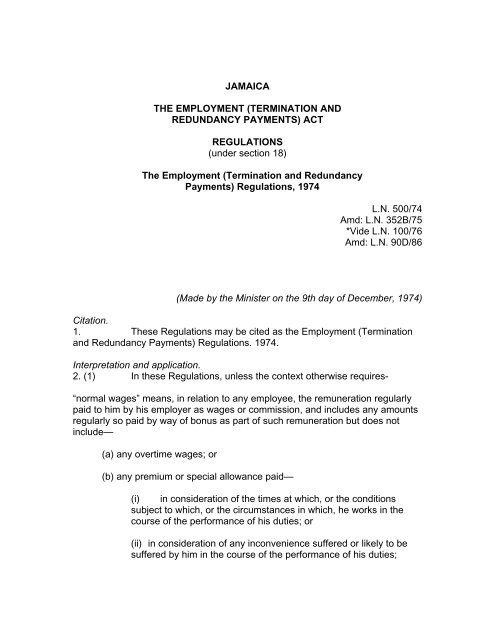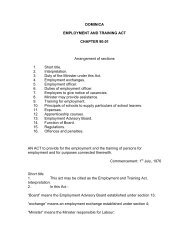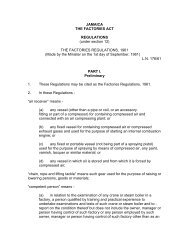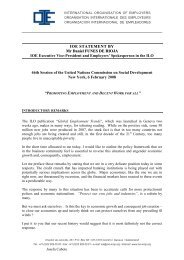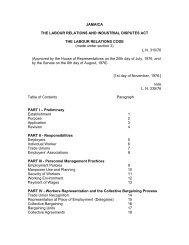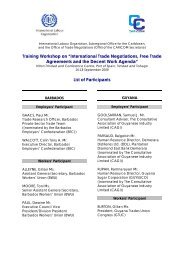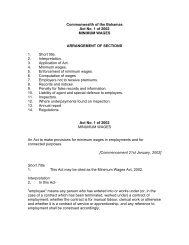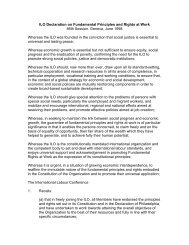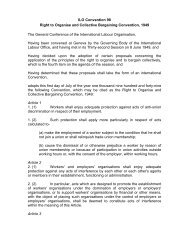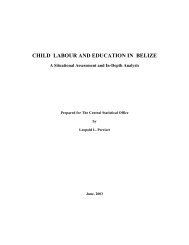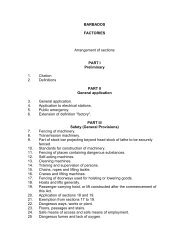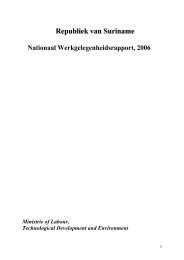(TERMINATION AND REDUNDANCY PAYMENTS) ACT ...
(TERMINATION AND REDUNDANCY PAYMENTS) ACT ...
(TERMINATION AND REDUNDANCY PAYMENTS) ACT ...
Create successful ePaper yourself
Turn your PDF publications into a flip-book with our unique Google optimized e-Paper software.
JAMAICA<br />
THE EMPLOYMENT (<strong>TERMINATION</strong> <strong>AND</strong><br />
<strong>REDUNDANCY</strong> <strong>PAYMENTS</strong>) <strong>ACT</strong><br />
REGULATIONS<br />
(under section 18)<br />
The Employment (Termination and Redundancy<br />
Payments) Regulations, 1974<br />
L.N. 500/74<br />
Amd: L.N. 352B/75<br />
*Vide L.N. 100/76<br />
Amd: L.N. 90D/86<br />
(Made by the Minister on the 9th day of December, 1974)<br />
Citation.<br />
1. These Regulations may be cited as the Employment (Termination<br />
and Redundancy Payments) Regulations. 1974.<br />
Interpretation and application.<br />
2. (1) In these Regulations, unless the context otherwise requires-<br />
“normal wages” means, in relation to any employee, the remuneration regularly<br />
paid to him by his employer as wages or commission, and includes any amounts<br />
regularly so paid by way of bonus as part of such remuneration but does not<br />
include—<br />
(a) any overtime wages; or<br />
(b) any premium or special allowance paid—<br />
(i) in consideration of the times at which, or the conditions<br />
subject to which, or the circumstances in which, he works in the<br />
course of the performance of his duties; or<br />
(ii) in consideration of any inconvenience suffered or likely to be<br />
suffered by him in the course of the performance of his duties;
“normal working week” means the number of days in a week on which the<br />
employee in relation to whom that expression is used is normally required to<br />
work for his employer;<br />
“week” means the period commencing immediately after twelve o’clock midnight<br />
on each Saturday and ending at twelve o’clock midnight on the Saturday next<br />
following;<br />
“year of employment” means fifty-two weeks (whether continuous or<br />
discontinuous) which, in accordance with these Regulations count in computing a<br />
period of employment<br />
2. (2) Where the relevant date does not fail at the end of a week, any<br />
reference in these Regulations to the relevant date shall be construed as a<br />
reference to the end of the week in which that date falls.<br />
2. (3) These Regulations apply—<br />
(a) in relation to contracts of employment made before the<br />
coming into force of these Regulations and subsisting at the<br />
coming into force of these Regulations: and<br />
(b) in relation to periods of employment commencing before the<br />
coming into force of these Regulations and subsisting at the<br />
coming into force of these Regulations,<br />
as they apply in relation to contracts of employment made, or periods of<br />
employment commencing, after the coming into force of these Regulations.<br />
Manner of computing period of employment.<br />
3. An employee’s period of employment shall be computed in weeks<br />
and accordingly the periods of five, ten and fifteen years mentioned in section 3<br />
of the Act shall be taken as 260, 520 and 780 weeks respectively.<br />
Periods which count.<br />
4. (1) Subject to paragraph (8). any week in which an employee is<br />
employed for eighteen hours or more shall count as one week in computing that<br />
employee’s period of employment.<br />
4. (2) Subject to paragraph (8). if in any week an employee is. for the<br />
whole or part of the week—<br />
(a) incapable of working in consequence of sickness or injury; or<br />
(b) absent from work on account of a temporary cessation of work; or
(c) absent from work in circumstances such that by arrangement or<br />
custom, he is regarded as continuing in the employment of his employer<br />
for all or any purposes.<br />
that week shall, notwithstanding that it does not fall under paragraph (1), count<br />
as one week in computing that employee’s period of employment.<br />
4. (3) If a business is transferred from one person to another, the period<br />
of employment of an employee in the business at the time of the transfer shall<br />
count as a period of employment with the transferee.<br />
4. (4) If an employee is. on the death of his employer, taken into the<br />
employment of a personal representative or trustee 01 the deceased employer,<br />
the employee’s period of employment with the deceased employer shall count as<br />
a period of employment with that personal representative or trustee.<br />
4. (5) If, after an interval of not more than two weeks after the ending of<br />
an employee’s contract of employment, his employer renews his contract or reengages<br />
him in accordance with paragraph (b) of subsection (6) of section 5 of<br />
the Act, the period of that interval shall count as a period of employment.<br />
4. (6) If there is a change in the partners, personal representatives or<br />
trustees who employ any person, that employee’s period of employment at the<br />
time of the change shall count as a period of employment with the partners,<br />
personal representatives or trustees (as the case may be) after the change.<br />
4. (7) Where an employee of a company is taken into the employment of<br />
another company which, at the time when he is taken into its employment, is an<br />
associated company of the first-mentioned company, his period of employment<br />
with the first-mentioned company shall count as a period of employment with the<br />
associated company.<br />
4. (8) Any week beginning after the coming into force of these<br />
Regulations shall not count under paragraph (I) or (2) if during that week, or any<br />
part of that week, the employee takes part in a strike which prevents him from<br />
working for more than eighteen hours in that week.<br />
4. (9) In this regulation “strike” means a concerted stoppage of work by a<br />
group of employees in contemplation or furtherance of an industrial dispute,<br />
whether those employees are parties to the dispute or not.<br />
4. (10) Where an employee is dismissed by his employer, and—<br />
(a) the dismissal is attributable wholly or partly to illness of the employee:<br />
and
(b) a redundancy payment is not paid to him: and<br />
(c) the contract of employment under which he was employed (hereafter<br />
referred to as “the previous contract”) is renewed, whether by the same or<br />
by another employer, or be is re-engaged under a new contract of<br />
employment, whether by the same or by another employer: and<br />
(d) the renewal or re-engagement takes effect after an interval of not<br />
more than twenty-six weeks after the ending of the previous contract,<br />
the continuity of the employee’s period of employment shall be treated as not<br />
having been broken by the interval referred to in sub-paragraph (d).<br />
Continuity not broken.<br />
5. (1) The continuity of an employee’s period of employment is not<br />
broken—<br />
(a) by the transfer referred to in paragraph (3) of regulation 4; or<br />
(b) by the death of his employer if he is taken into the employment of a<br />
personal representative or trustee of the deceased; or<br />
(c) by the interval referred to in paragraph (5) of regulation 4; or<br />
(d) by the change referred to in paragraph (6) of regulation 4: or<br />
(e) by a change of employment in the circumstances mentioned in<br />
paragraph (7) of regulation 4; or<br />
(f) by any week which does not count by virtue of paragraph (8) of<br />
regulation 4; or<br />
(g) by any period during which the employee is absent from work because<br />
of a lock-out by his employer; or<br />
(h) by any period during which he is absent from work for the purpose of<br />
carrying out any duty imposed on him by the Government or any work<br />
which he carries out at the request of the Government with the permission<br />
of his employer.<br />
5. (2) In this regulation “lock-out” means action which, in contemplation or<br />
furtherance of an industrial dispute, is taken by one or more employers, whether<br />
parties to the dispute or not, and which consists of the exclusion of employees<br />
from one or more places of employment or of the suspension of work in one or<br />
more such places or of the collective, simultaneous or otherwise connected<br />
termination or suspension of employment of a group of employees.
Remuneration in respect of period of notice.<br />
6. (1) The remuneration of an employee in respect of each week of a<br />
period of notice shall—-<br />
(a) in the case of an employee who has been employed at time rates, be<br />
the normal wages earned by him in respect of the last normal working<br />
week preceding the relevant date during which he has worked for his<br />
employer; and<br />
(b) in the case of an employee who has been employed at piece or task<br />
rates or on a commission basis, be one-quarter of the aggregate normal<br />
wages earned by him in respect of the last four working weeks preceding<br />
the relevant date during which he has worked for his employer.<br />
6. (2) Any payment made to an employee by his employer as holiday<br />
remuneration, on the termination of that employee’s employment shall not be<br />
taken into account as part of his remuneration in respect of the period of notice.<br />
Prescribed diseases Schedule.<br />
7. (1) Each of the diseases set out in the first column of the Schedule is a<br />
prescribed disease for the purposes of paragraph (c) of subsection (2) of section<br />
5 of the Act<br />
7. (2) If any employee who is employed in any occupation set out in the<br />
second column of the Schedule develops a disease set out against that<br />
occupation in the first column of the Schedule, that disease shall, unless the<br />
contrary is proved, be presumed to be due to the nature of his employment.<br />
7. (3) Where the employer of any employee who is employed In any<br />
occupation set out in the second column of the Schedule wishes to ascertain—<br />
(a) whether that employee has developed a prescribed disease; or<br />
(b) whether a prescribed disease which that employee has developed is<br />
due to the nature of his employment.<br />
the employer may require him to submit himself to a medical examination by a<br />
medical practitioner chosen and paid by the employer.<br />
7. (4) An employee who is required to submit himself to a medical<br />
examination pursuant to paragraph (3) is entitled to require that a medical<br />
practitioner chosen and paid by him shall be given an opportunity to be present<br />
at the medical examination.<br />
7. (5) Where, as respects any of the questions mentioned in sub-
paragraphs (a) and (b) of paragraph (3), there is disagreement between a<br />
medical practitioner chosen by an employer and one chosen by an employee, the<br />
matter shall be referred to the Chief Medical Officer, and any decision made by<br />
him in connection therewith shall be final.<br />
Manner of calculating redundancy payments except for seasonal employees.<br />
8. (1) Subject to paragraph (2) the amount of the redundancy payment to<br />
which an employee other than an employee engaged in seasonal employment is<br />
entitled in respect of any period, ending with the relevant date, during which the<br />
employee has been continuously employed, shall be-<br />
(a) in respect of a period not exceeding ten years of employment the sum<br />
arrived at by multiplying two weeks’ pay by the number of years;<br />
(b) in respect of a period of more than ten years of employment-<br />
(I)<br />
(ii)<br />
for the first ten years reckoned, the sum arrived at by<br />
multiplying two weeks’ pay by that number of years; and<br />
for the years remaining, the sum arrived at by multiplying<br />
three weeks’ pay by the number of such remaining years.<br />
8. (2) For the purposes of paragraph (1)—<br />
(a) the period during which an employee has been continuously employed<br />
shall be computed in accordance with regulations 3, 4 and 5:<br />
(b) the number of years of employment falling within that period shall be<br />
reckoned backwards, starting with the relevant date, so, however, that<br />
where there is a part of a year -of employment remaining over, that part—<br />
(i) shall be disregarded if it does not exceed thirteen weeks;<br />
(ii)<br />
(iii)<br />
shall be reckoned as one-half of one year of employment if it<br />
exceeds thirteen weeks but does not exceed thirty-nine<br />
weeks: and<br />
shall be reckoned as one year of employment if it exceeds<br />
thirty-nine weeks:<br />
(c) “three weeks’ pay” means-<br />
(i) three times the normal wages earned by the employee in<br />
respect of the last normal working week preceding the<br />
relevant date during which he has worked; or<br />
(ii)<br />
3/13 of the aggregate normal wages earned by him in<br />
respect of the last thirteen normal working weeks preceding
whichever is the greater;<br />
the relevant date during which he has worked.<br />
“two weeks’ pay” means—<br />
(i)<br />
twice the normal wages earned by the employee in respect<br />
of the last normal working week preceding the relevant date<br />
during which he has worked: or<br />
(ii)<br />
2/13 of the aggregate normal wages earned by him in<br />
respect of the last thirteen normal working weeks preceding<br />
the relevant date during which he has worked,<br />
whichever is the greater.<br />
Manner of calculating redundancy payment for seasonal employees.<br />
9. (1) Subject to paragraph (2) the amount of the redundancy payment to<br />
which an employee engaged in seasonal employment is entitled in respect of<br />
consecutive years in which that employee has been engaged in continuous<br />
seasonal employment, shall be.—<br />
(a) where the number of consecutive years does not exceed ten. the sum<br />
arrived at by multiplying two weeks’ pay by the number of years;<br />
(b) where there are more than ten consecutive years-<br />
(i)<br />
(ii)<br />
for the first ten years reckoned, the sum arrived at by<br />
multiplying two weeks’ pay by that number of years; and<br />
for the years remaining, the sum arrived at by multiplying<br />
three weeks’ pay by the number of such remaining years.<br />
9. (2) For the purposes of paragraph (1)—<br />
(a) an employee is engaged in continuous seasonal employment during<br />
any season in which-<br />
(i)<br />
(ii)<br />
he works for not less than ninety days in the seasonal<br />
employment provided by his employer: or<br />
where the number of days of work referred to in subparagraph<br />
(i) cannot be ascertained, he has earned, as<br />
normal wages in the seasonal employment provided by his
employer, a sum equivalent to or greater than ninety times<br />
the established daily rate for the category of work performed<br />
by him in an area where there is such established daily rate;<br />
or<br />
(iii)<br />
where the number of days of work referred to in subparagraph<br />
(i) cannot be ascertained and there is no<br />
established daily rate of the kind referred to in subparagraph<br />
(ii), his name appeared on the pay-bills of his<br />
employer in respect of seasonal employment for not less<br />
than sixteen weeks;<br />
(b) the number of consecutive years in which an employee has been<br />
engaged in continuous seasonal employment shall be reckoned<br />
backwards, starting with the last year preceding the relevant date;<br />
(c) “three weeks’ pay” means 3/104 of the aggregate normal wages<br />
earned by the employee in the seasonal employment in which he has<br />
been engaged during the last two consecutive years preceding the<br />
relevant date;<br />
“two weeks’ pay” means 2/104 of the aggregate normal wages earned by<br />
the employee in the seasonal employment in which he has been engaged<br />
during the last two consecutive years preceding the relevant date.<br />
10. The record required by section 16 of the Act to be kept by every<br />
employer shall contain-<br />
(a) the name and address of the employer;<br />
(b) the name and address of the employee:<br />
(c) the date on which the employment of the employee commenced and;<br />
in the case of an employee who has been re-employed after the<br />
termination of his contract of employment, the date on which the reemployment<br />
commenced;<br />
(d) an accurate description of the place at which the employee was<br />
ordinarily resident when he was engaged under the contract of<br />
employment;<br />
(e) an accurate description of the place at which the employee was<br />
present when the offer of employment was made to him by any means<br />
other than by advertisement or at which the contract of employment was<br />
made;
(f) information as to the rate of the normal wages of the employee and<br />
his normal working week;<br />
(g) where the contract of employment of the employee has been<br />
terminated, particulars as to—<br />
(i)<br />
(ii)<br />
the relevant date;<br />
the period, ending with the relevant date, during which he was<br />
continuously employed or. if he was engaged in seasonal<br />
employment, the number of consecutive years for which he<br />
was engaged in continuous seasonal employment;<br />
(iii) the amount of redundancy payment, if any, paid to him.<br />
Saving.<br />
11. Nothing in these Regulations shall be construed as preventing any<br />
employee from being paid more than the amount which he is entitled to receive<br />
under these Regulations as redundancy payment or as remuneration during a<br />
period of notice.<br />
Schedule<br />
(Regulation 7)<br />
In this Schedule “pneumoconiosis” means fibrosis of the lungs caused by<br />
sclerogenetic mineral dust, and- includes silico-tuberculosis where silicosis is an<br />
essential factor in causing incapacity for work. -<br />
Description of Disease<br />
Nature of Occupation<br />
1. Pneumoconiosis. All occupations involving exposure to<br />
the risk concerned.<br />
2. Disease caused by beryllium or its<br />
toxic compounds.<br />
All occupations involving exposure to<br />
the risk concerned.<br />
3. Disease caused by phosphorous or<br />
its toxic compounds.<br />
All occupations involving exposure to<br />
the risk concerned<br />
4. Disease caused by chrome or its<br />
toxic compounds.<br />
All occupations involving exposure to<br />
the risk concerned<br />
5. Disease caused by manganese or its All occupations involving exposure to<br />
toxic compounds.<br />
the risk concerned<br />
6. Disease caused by arsenic or its<br />
toxic compounds.<br />
All occupations involving exposure to<br />
the risk concerned<br />
7. Disease caused by mercury or its<br />
toxic compounds.<br />
All occupations involving exposure to<br />
the risk concerned<br />
8. Disease caused by lead or its toxic<br />
compounds.<br />
All occupations involving exposure to<br />
the risk concerned
9. Disease caused by carbon<br />
bisulphide.<br />
All occupations involving exposure to<br />
the risk concerned<br />
10. Disease caused by toxic halogen<br />
exposure derivatives of<br />
All occupations involving exposure to<br />
the risk concerned<br />
hydrocarbons of the aliphatic<br />
series<br />
11. Disease caused by benzene or its<br />
toxic homologues<br />
All occupations involving exposure to<br />
the risk concerned<br />
12. Disease caused by nitro- and amidotoxic<br />
derivatives of benzene or its<br />
All occupations involving exposure to<br />
the risk concerned<br />
homologues<br />
13. Disease caused by ionising<br />
radiation.<br />
All occupations involving exposure to<br />
the risk concerned<br />
14. Primary epitheliomatous cancer of<br />
the skin caused by tar, pitch,<br />
All occupations involving exposure to<br />
the risk concerned<br />
bitumen, mineral oil, or the<br />
compounds, products or red-dues<br />
of those substances.<br />
15. Anthrax infection, All occupations involving:<br />
a) work in connection with animals<br />
infected with anthrax;<br />
b) handling of animals carcasses or<br />
parts of such carcasses including<br />
hides, hoofs and horns;<br />
c) loading or unloading or transport<br />
of merchandise which may have<br />
been contaminated by animals or<br />
animal carcasses infected with<br />
anthrax.


